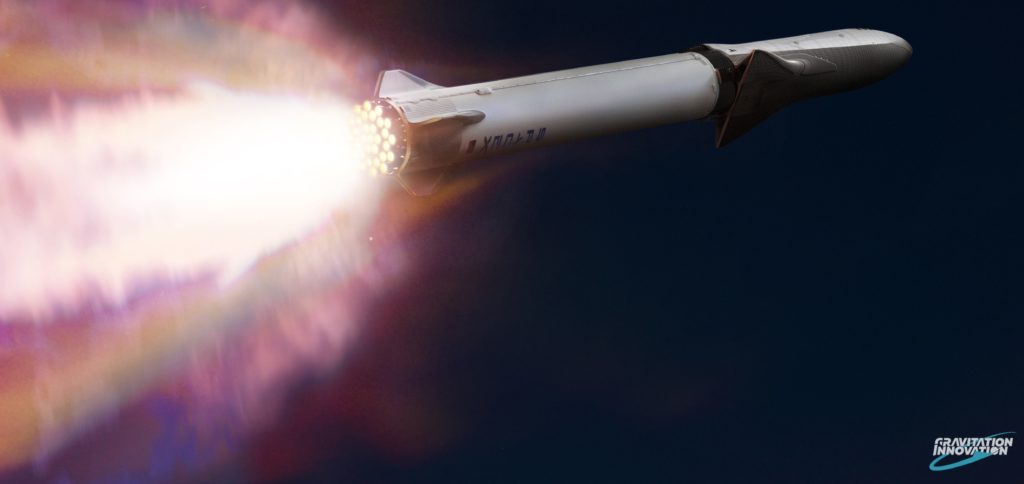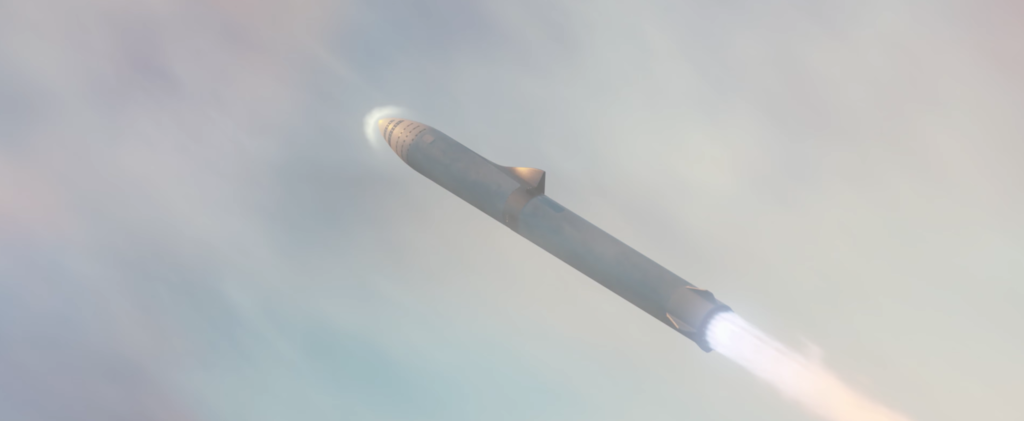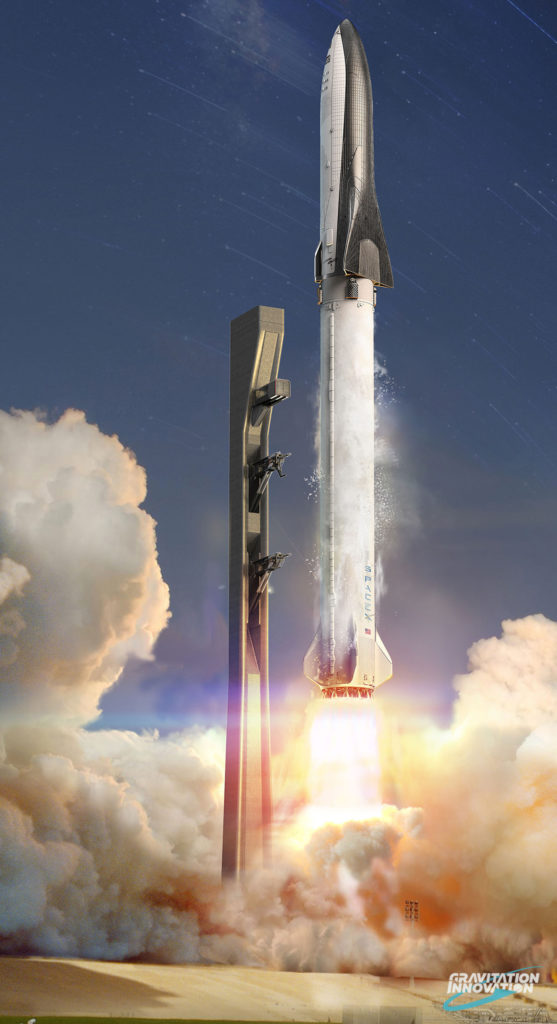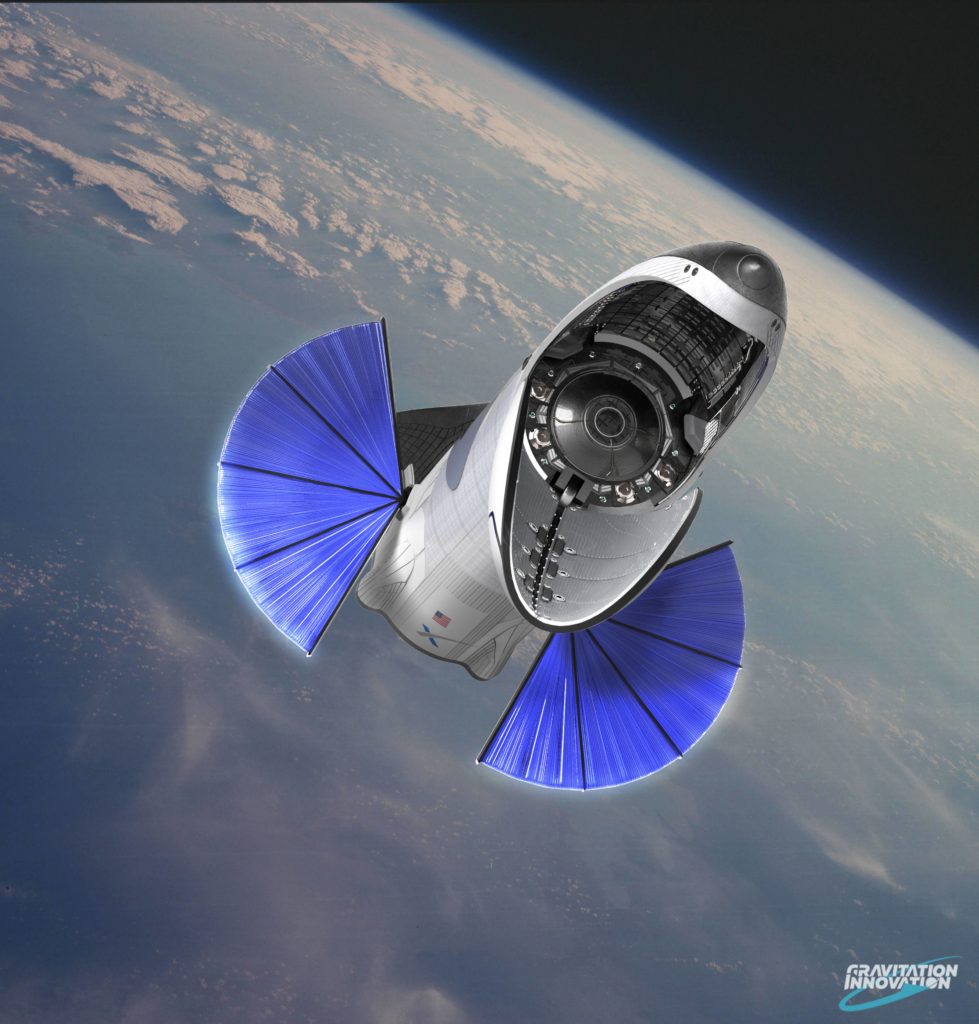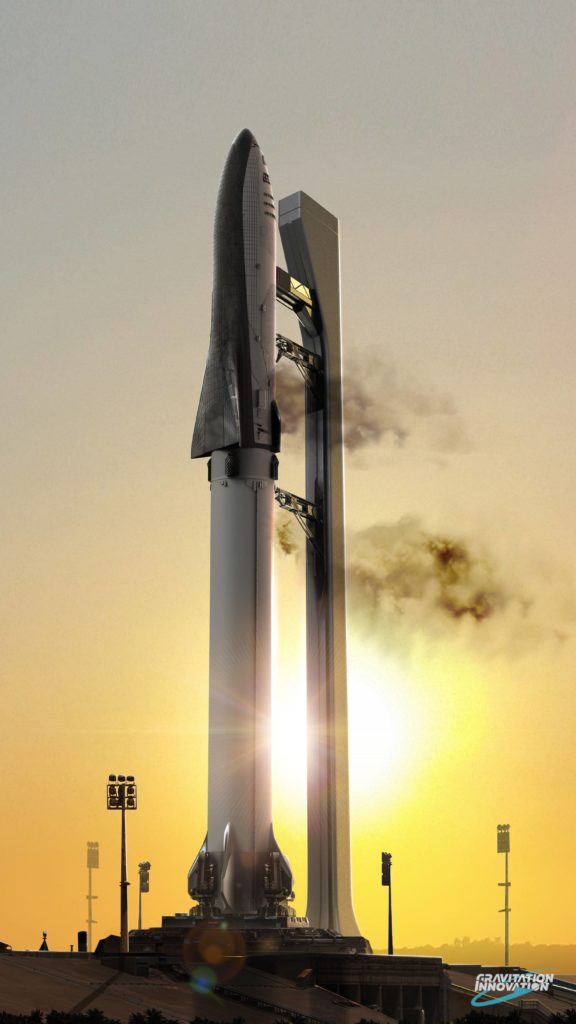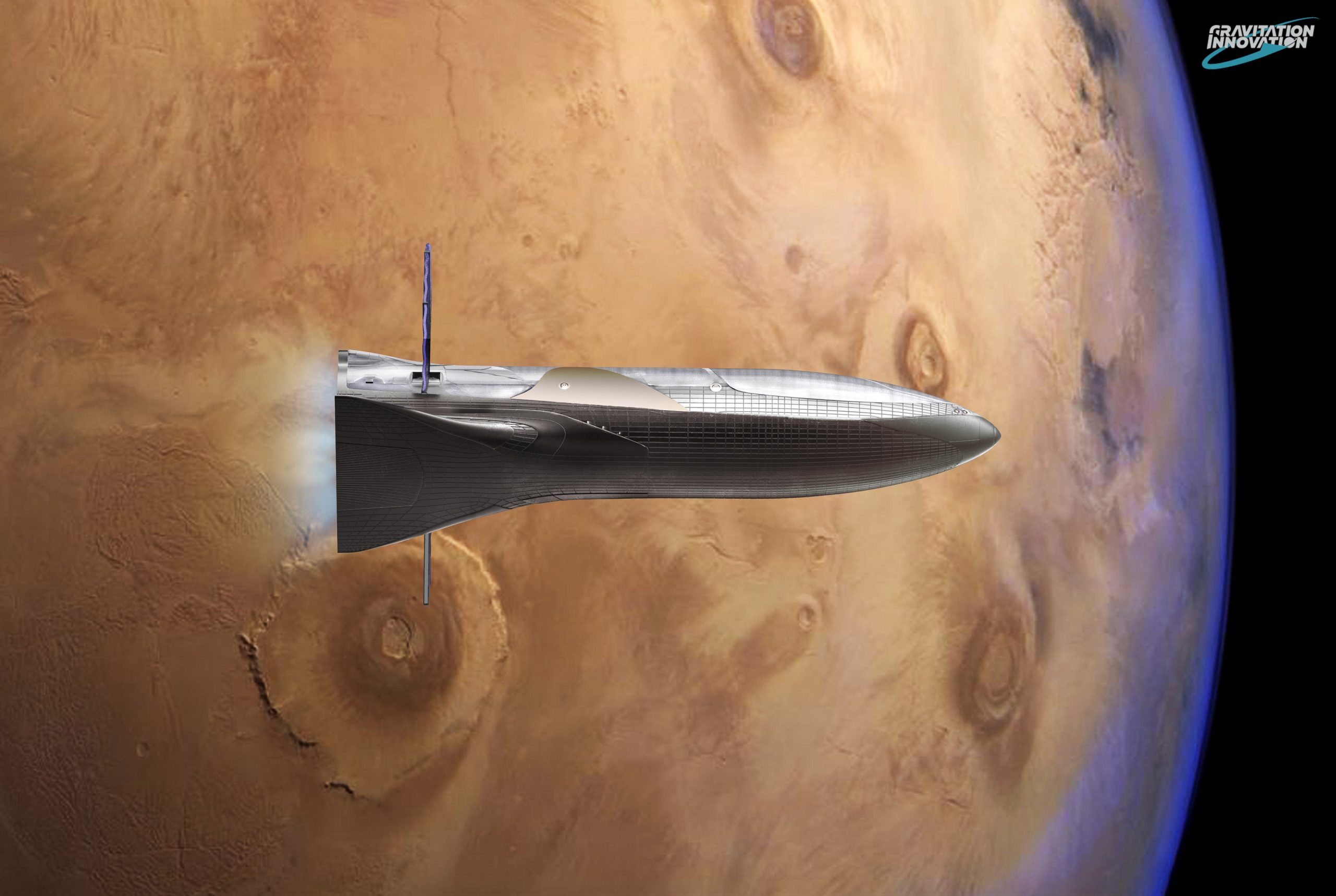
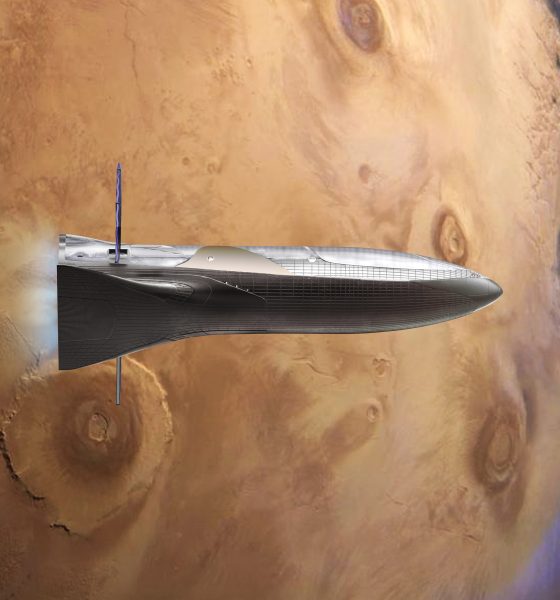
SpaceX
SpaceX’s BFR Mars rocket and spaceship rendered in extraordinary fan artwork
Part of a newly-formed group known as Gravitation Innovation, artist and spaceflight fan David Romax published an extraordinary series of concept artwork focused solely on SpaceX’s massive next-generation Mars rocket, known as the Big F—— Rocket (BFR). Generously published with the intent of providing SpaceX fans with a number of digital wallpapers, Romax’s work acts as an amazing companion to SpaceX’s own small collection of BFR renderings, perhaps even surpassing the company’s concept art in some cases.
David was inspired to create a series of BFR-themed wallpapers by a friend who had urged him to put his skills as a 3D modeler and artist to work for SpaceX (or at least the large community of fans built around the rocket company) by producing unofficial renders of its rockets – produce he most certainly did, and the results of his efforts are easily some of the best examples of unofficial artwork ever created by SpaceX enthusiasts.

Effectively unreleased, an updated Mars colonization video shown in 2018 replaces 2016’s ITS with the newer BFR design. (SpaceX)
Due to an understandable lack of technical detail available in the concept imagery SpaceX has thus far published for BFR and the earlier Interplanetary Transport System (ITS), Romax had to rely on aesthetic and technical intuition almost constantly over the process of producing his own artist impressions of BFR. In a number of cases, a matte painting style was used to ensure extraordinary realism by integrating real aspects of SpaceX’s current launch facilities and signatures of its active Falcon 9 and Falcon Heavy launch vehicles and its Crew and Cargo Dragon spacecraft, reaching a level of believable detail that effortlessly surpasses similar media created by SpaceX.
- David Romax’s artwork has blown away a number of SpaceX (and general spaceflight) fans since he shared them earlier this week. (David Romax/Gravitation Innovation)
- .While SpaceX’s own visualizations are gorgeous and thrilling in their own rights, Romax’s interpretation adds an unparalleled level of shock and awe. (SpaceX)
Of course, a comparative lack of extreme detail is really not any fault of SpaceX: given the preliminary nature of the designs of both BFR and ITS at the time they were publicly revealed (September 2016 and 2017), adding details that extended beyond the actual scope of current design work (thus treading into the realm of speculation) would be fundamentally counterproductive for a company more recently keen on showing off results over parading what can be described as ‘paper rockets’. In both the ITS and BFR reveals, CEO Elon Musk’s presentations were repeatedly (and pointedly) punctuated with truly surprising reveals of real, physical progress with mature rocket R&D programs and extensive prototype testing.
Regardless, the level of detail Romax so elegantly and seamlessly integrated into SpaceX’s preliminary Mars rocket booster and crew and cargo spaceship designs is shockingly convincing and adds a level of depth and drama that is unique in fan renderings of SpaceX’s vehicles. It certainly helps that today, nearly a year after BFR was first unveiled, SpaceX’s hardware development for BFR is far more mature. Currently, those tangible efforts range from thousands of seconds of hot-fire testing of the rocket’s Raptor propulsion system to tangible work beginning on the flight version of that advanced engine, as well as a huge temporary tent housing preliminary BFR production tooling while construction is just beginning at a different Port of Los Angeles-located plot of land intended to support the first dedicated BFR factory within 12-18 months. One step further, SpaceX’s highly reusable upgrade to Falcon 9 and Heavy, known as Block 5, has already debuted and will soon put SpaceX’s experience with rocket reuse to the test.
- SpaceX’s BFR. (Gravitation Innovation/David Romax)
- The cargo version of the BFS (Big F- Spaceship) rendered by David Romax, including a number of educated guesses at what it might look like and how it might function. At the request of a friend, artist David Romax put together a truly jaw-dropping collection of concept art featuring SpaceX’s BFR rocket and its Cargo and Crew spaceships. (Gravitation Innovation/David Romax)
- BFR prepares for launch as the sun sets over the upgraded LC-39A, built off a concept of the future modifications included in SpaceX’s 2016 and 2017 video updates. At the request of a friend, artist David Romax put together a truly jaw-dropping collection of concept art featuring SpaceX’s BFR rocket and its Cargo and Crew spaceships. (Gravitation Innovation/David Romax)
All thanks to David Romax and Gravitation Innovation for the amazing artwork and the unflinching dedication to the future of spaceflight. Download the wallpapers in full-resolution here.
Follow us for live updates, peeks behind the scenes, and photos from Teslarati’s East and West Coast photographers.
Teslarati – Instagram – Twitter
Tom Cross – Twitter
Pauline Acalin – Twitter
Eric Ralph – Twitter

Elon Musk
Elon Musk’s Biggest Revelations on AI, Robots, and the Future of Work from the Moonshots Podcast

Elon Musk’s appearance on the Moonshots with Peter Diamandis podcast was packed with bold predictions, candid admissions, and surprising tech insights. The nearly three-hour conversation covered everything from artificial intelligence to humanoid robots, geopolitics, and the future of work. Here are the top 10 most intriguing takeaways:
-
Aggressive AGI Timeline Predictions
Musk offered a detailed view on when artificial general intelligence (AGI) could emerge, suggesting it may arrive sooner than many expect, emphasizing both transformative potential and risks.
-
U.S. vs. China in the AI Race
He discussed the strategic competition between the United States and China over AI development, noting that geopolitical dynamics will shape how and who leads in the next decades.
-
Future of Job Markets
Musk touched on how AI and automation could reshape employment, predicting massive boosts in productivity alongside potential disruptions in traditional work structures.
-
Clean Energy Transition
A recurring theme was the role of clean energy in future economies, with Musk reiterating the importance of scaling sustainable power generation and storage.
-
Humanoid Robots Are Coming
On the podcast, Musk elaborated on Tesla’s work on humanoid robots, hinting at timelines and applications that go beyond factories to general-purpose assistance.
-
Tesla Roadster “Last Human-Driven Car”
Outside the core discussion topics, Musk teased features of the upcoming Tesla Roadster — calling it “the best of the last of the human-driven cars” and suggesting safety won’t be its main selling point.
-
The Role of AI in Clean Energy and Robotics
Linking AI to both energy optimization and robotics, Musk explained how smarter systems could accelerate decarbonization and task automation across industries.
-
U.S. Innovation Leadership
Musk argued that maintaining American leadership in key tech sectors like AI, space, and robotics should be a national priority, with thoughtful policy and investment.
-
Job Creation vs. Job Elimination
While acknowledging automation’s disruptive effects, he also outlined scenarios where new industries and opportunities could emerge, particularly in AI, space, and advanced manufacturing.
-
Long-Term Vision for Humanity
Throughout the conversation, Musk revisited his long-term philosophical views — including a belief in humanity’s responsibility to become a multi-planetary and technologically empowered species.
Whether you agree with Musk’s optimism or not, the podcast offers a window into the thinking of one of the most influential figures in tech today, in and why his visions continue to spark debate and inspiration.
Elon Musk
Starlink achieves major milestones in 2025 progress report
Starlink wrapped up 2025 with impressive growth, adding more than 4.6 million new active customers and expanding service to 35 additional countries, territories, and markets.

Starlink wrapped up 2025 with impressive growth, adding more than 4.6 million new active customers and expanding service to 35 additional countries, territories, and markets. The company also completed deployment of its first-generation Direct to Cell constellation, launching over 650 satellites in just 18 months to enable cellular connectivity.
SpaceX highlighted Starlink’s impressive 2025 progress in an extensive report.
Key achievements from Starlink’s 2025 Progress
Starlink connected over 4.6 million new customers with high-speed internet while bringing service to 35 more regions worldwide in 2025. Starlink is now connecting 9.2 million people worldwide. The service achieved this just weeks after hitting its 8 million customer milestone.
Starlink is now available in 155 markets, including areas that are unreachable by traditional ISPs. As per SpaceX, Starlink has also provided over 21 million airline passengers and 20 million cruise passengers with reliable high-speed internet connectivity during their travels.
Starlink Direct to Cell
Starlink’s Direct to Cell constellation, more than 650 satellites strong, has already connected over 12 million people at least once, marking a breakthrough in global mobile coverage.
Starlink Direct to Cell is currently rolled out to 22 countries and 6 continents, with over 6 million monthly customers. Starlink Direct to Cell also has 27 MNO partners to date.
“This year, SpaceX completed deployment of the first generation of the Starlink Direct to Cell constellation, with more than 650 satellites launched to low-Earth orbit in just 18 months. Starlink Direct to Cell has connected more than 12 million people, and counting, at least once, providing life-saving connectivity when people need it most,” SpaceX wrote.
Elon Musk
Starlink passes 9 million active customers just weeks after hitting 8 million
The milestone highlights the accelerating growth of Starlink, which has now been adding over 20,000 new users per day.

SpaceX’s Starlink satellite internet service has continued its rapid global expansion, surpassing 9 million active customers just weeks after crossing the 8 million mark.
The milestone highlights the accelerating growth of Starlink, which has now been adding over 20,000 new users per day.
9 million customers
In a post on X, SpaceX stated that Starlink now serves over 9 million active users across 155 countries, territories, and markets. The company reached 8 million customers in early November, meaning it added roughly 1 million subscribers in under seven weeks, or about 21,275 new users on average per day.
“Starlink is connecting more than 9M active customers with high-speed internet across 155 countries, territories, and many other markets,” Starlink wrote in a post on its official X account. SpaceX President Gwynne Shotwell also celebrated the milestone on X. “A huge thank you to all of our customers and congrats to the Starlink team for such an incredible product,” she wrote.
That growth rate reflects both rising demand for broadband in underserved regions and Starlink’s expanding satellite constellation, which now includes more than 9,000 low-Earth-orbit satellites designed to deliver high-speed, low-latency internet worldwide.
Starlink’s momentum
Starlink’s momentum has been building up. SpaceX reported 4.6 million Starlink customers in December 2024, followed by 7 million by August 2025, and 8 million customers in November. Independent data also suggests Starlink usage is rising sharply, with Cloudflare reporting that global web traffic from Starlink users more than doubled in 2025, as noted in an Insider report.
Starlink’s momentum is increasingly tied to SpaceX’s broader financial outlook. Elon Musk has said the satellite network is “by far” the company’s largest revenue driver, and reports suggest SpaceX may be positioning itself for an initial public offering as soon as next year, with valuations estimated as high as $1.5 trillion. Musk has also suggested in the past that Starlink could have its own IPO in the future.
